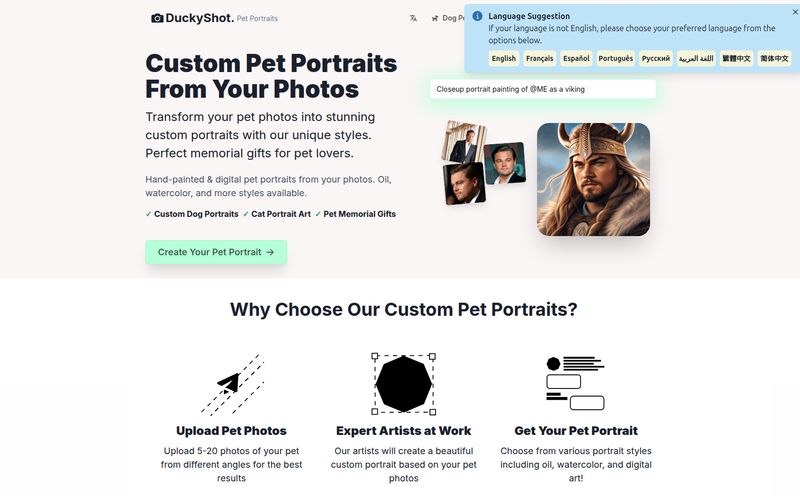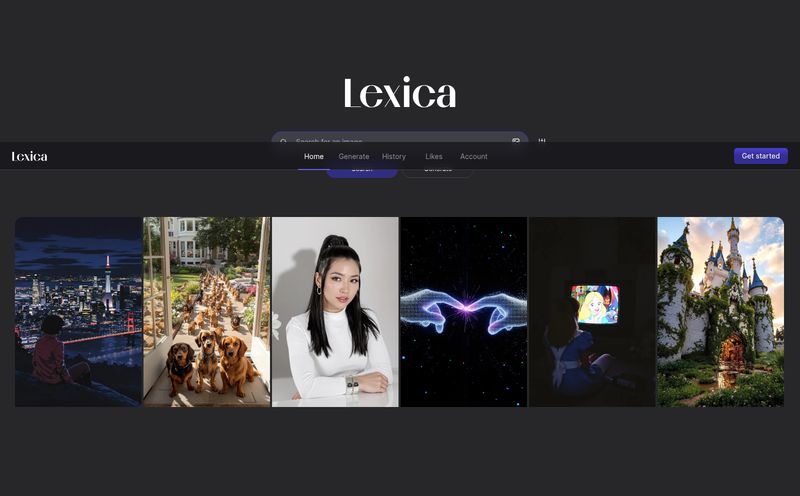If you’ve spent any time in the wild world of AI art generation, you know the feeling. You’re scrolling through X (what I still want to call Twitter), or maybe a Discord server, and you see it. The perfect image. The style is exactly what you’ve been trying to create for weeks. It has that painterly feel, or that crisp anime line art, or that gritty cyberpunk photorealism. Your first thought isn't just 'wow,' it's 'HOW?'
You know it's probably a custom Stable Diffusion model, likely a checkpoint or a LoRA someone trained meticulously. But which one? There are thousands upon thousands hosted on platforms like CivitAI. Finding the right one can feel like searching for a specific grain of sand on a very, very large beach. So, when I first heard about a tool called FindSD.art, my ears perked up. The promise was simple, almost elegant: use an image to find the model. A Shazam for AI art styles. Genius, right?
But then, something strange happened. Like a lot of promising projects in the AI space, it seems to have… vanished. Its a digital ghost.
What Exactly Was FindSD.art?
From what I could gather, FindSD.art was designed to be the ultimate shortcut for us aesthetically-obsessed AI artists. The concept was beautiful in its simplicity. You’d take an image you liked, upload it to their site, and their system would analyze the art style and spit back a list of the most likely Stable Diffusion models from CivitAI that could replicate it. No more endless scrolling or guessing keywords. Just point, click, and create.
For anyone who has spent hours typing descriptors like “ghibli-esque, miyazaki-inspired, watercolor, soft lighting” into the CivitAI search bar only to get mixed results, you can immediately see the appeal. It aimed to take the guesswork out of the equation. In my experience, half the battle in AI art generation isn't the prompt, but the foundation you build it on—the model.

Visit FindSD.art
The Alluring Promise of a Simple Solution
The potential here was massive. The tool promised a few key things that made it stand out from the noise.
First, the sheer speed and ease of use. The idea of getting a direct match in seconds is a game-changer. It lowers the barrier to entry for newcomers and saves veterans like myself a ton of time. Time is traffic, and time is money, after all. The user interface was described as incredibly straightforward, which is always a plus. We don’t need another tool with a learning curve steeper than K2.
Second, it was laser-focused on CivitAI. While some might see this as a limitation (and we'll get to that), it was also a strength. CivitAI is the de facto hub for the Stable Diffusion community's custom models. By concentrating its search there, FindSD.art was tapping directly into the richest, most diverse ecosystem of user-generated models on the internet. Why boil the ocean when you can fish in the most well-stocked lake?
Finally, it was billed as privacy-focused. In an era where every click feels like it's being fed into some massive data-hoovering algorithm, a tool that respects user privacy is a breath of fresh air. This little detail suggests the creator understood the community's ethos, which is a big green flag in my book.
Of Course, There's Always a Catch
No tool is perfect, and FindSD.art had its theoretical weak spots. The biggest one is obvious: its output would only ever be as good as the input. The old “garbage in, garbage out” principle. A low-res, heavily-compressed JPEG from social media probably wouldn't yield great results. You'd need a clean, clear example of the style for the matching algorithm to really do its job.
And yes, the reliance on CivitAI, while smart, was also a constraint. What about fantastic models hosted exclusively on Hugging Face or a creator's personal Patreon or GitHub? You'd be out of luck. But for a free, simple tool, that’s a tradeoff I think most of us would have happily made. You can’t expect a single tool to do everything.
So… What Happened? A Domain for Sale
This brings us to the mystery. If you go to findsd.art today, you won't find a cool AI tool. You'll find a landing page from a domain broker, Sedo, offering to sell you the domain for a cool $716. Ouch.
What does this mean? It's hard to say for sure, but we can speculate. This happens a lot in the tech world, especially in a gold rush like the current AI boom. My best guess? It was likely a passion project by a solo developer. Maybe the server costs got too high, or they didn't have time to maintain it, or maybe they just lost interest. Running a free service that processes images can get expensive fast. It’s also possible it was acquired by a larger company and then quietly shuttered, a process we call an “acqui-hire” where the talent is the real prize, not the product.
Whatever the reason, it's a small reminder of the ephemeral nature of many of the tools we come to rely on. One day they're here, solving a real problem, and the next, they're just a 404 error and a memory.
How to Find AI Models by Style Without FindSD.art
Don't despair! The dream isn't dead, we just have to go back to doing things the old-fashioned way. It's a bit more work, but totally doable. Here's my current workflow:
- Reverse Image Search is Your Friend: Use Google Lens or Tineye on the image. You're not looking for the model, you're looking for the source. Often, this will lead you to a Reddit post, a DeviantArt page, or a tweet where the creator might have mentioned the model or prompts they used.
- Become a Keyword Detective on CivitAI: Once you have a lead—an artist's name, a character, or even just better style descriptors—take that to the CivitAI search. Get creative with your tags. Look not just at the model names, but at the user-submitted images for each model. This is often where you'll find the visual confirmation you need.
- Use a CLIP Interrogator: For the more technically inclined, tools like the CLIP Interrogator (you can find versions on Hugging Face) can analyze an image and suggest text prompts that would create it. While it won't name the specific model, the prompt it generates can be a powerful clue, giving you keywords to search for on CivitAI.
It's not as slick as a one-click solution, but it gets the job done. It turns you into a bit of an AI art archaeologist, digging for digital artifacts. It can be frustrating, but sometimes, the hunt is part of the fun.
The Bigger Picture for AI Tool Discovery
The story of FindSD.art, whether it was a flash in the pan or just an idea that never fully launched, points to a much bigger problem in the generative AI space: discovery. The ecosystem is growing exponentially, but our ability to navigate it is lagging behind. It’s fragmented. It's chaotic. It's the wild west.
There's a massive opportunity for someone to build a robust, sustainable version of what FindSD.art was trying to be. A true meta-search engine for AI models, perhaps with a community-driven tagging system. For now, we're left with our wits and a collection of bookmarks. But the need is there, and where there's a need, eventually, a solution will appear. I'm keeping my eyes peeled.
Frequently Asked Questions
- What was FindSD.art?
- FindSD.art was a proposed online tool designed to help users discover Stable Diffusion models on CivitAI by analyzing the art style of an uploaded image. It aimed to simplify the process of matching a desired look to a specific AI model.
- Is FindSD.art still available?
- No, it appears FindSD.art is no longer active. The domain name is currently listed for sale, indicating the original project has been discontinued.
- How can I find Stable Diffusion models by style now?
- You can use a combination of methods: reverse image search to find the original artist or post, manual keyword searching on platforms like CivitAI, and using advanced tools like a CLIP Interrogator to generate descriptive prompts from an image.
- Was FindSD.art a free tool?
- Based on the available information and its nature as a community-facing tool, it was almost certainly intended to be free to use, possibly supported by donations or ads later on.
- Why is finding the right AI model so difficult?
- The AI model ecosystem is vast, decentralized, and growing incredibly fast. There isn't a standardized naming or tagging system, so finding a specific style relies heavily on the creator's description and community discovery, which can be inconsistent.
- What is CivitAI?
- CivitAI is the largest and most popular online hub for sharing, discovering, and downloading custom models, embeddings, and other resources for AI art generation, particularly for the Stable Diffusion platform.
Conclusion
So, we pour one out for FindSD.art—a fantastic idea that, for whatever reason, didn't make it. It's a classic tale from the frontier of new technology. It highlights a genuine pain point for creators and serves as a testament to the ingenuity bubbling within the AI community. While this specific tool may be gone, the problem it tried to solve remains. And I have no doubt that other developers are out there right now, working on the next great solution. The machine keeps learning, and so do we.
References and Sources
- CivitAI - The primary hub for Stable Diffusion models.
- CLIP Interrogator on Hugging Face - An example of a tool for generating prompts from images.
- Sedo Domain Marketplace - The platform currently listing the findsd.art domain.



